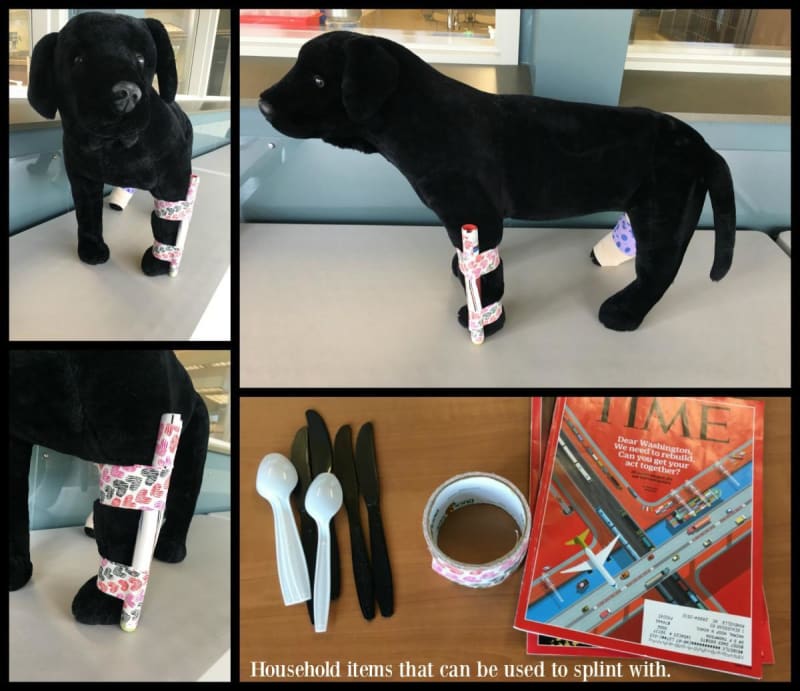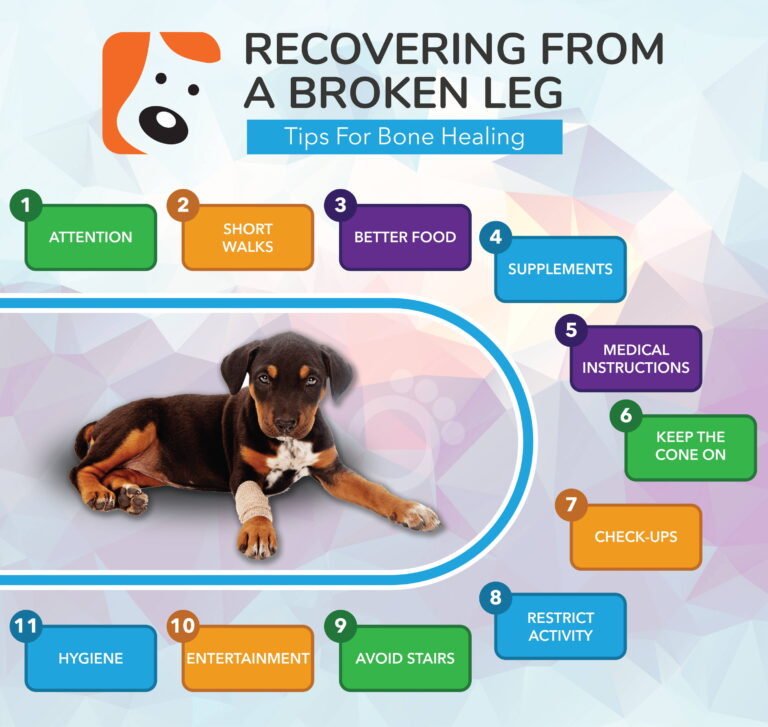To fix a dog’s broken leg at home, first, gently immobilize the leg to prevent further injury, and then take your dog to the veterinarian immediately for professional care. Treating a broken leg at home without proper veterinary guidance can lead to complications and may exacerbate the injury.
A broken leg in a dog can be a distressing situation for both the pet and the owner. It is essential to remain calm and take immediate action to ensure the well-being of the dog. Knowing how to provide initial aid until professional help is available is crucial.
This article will provide helpful guidance on how to approach a dog’s broken leg at home, emphasizing the importance of seeking veterinary care and the initial steps to take to alleviate the dog’s discomfort and prevent further injury. Let’s explore the necessary precautions and measures to effectively handle a dog’s broken leg at home while awaiting professional medical attention.
Recognizing A Broken Leg
When it comes to our furry friends, ensuring their health and safety is of utmost importance. If you suspect that your dog may have a broken leg, it’s essential to recognize the signs as early as possible. Time is of the essence in offering them the necessary care and treatment. This blog post will guide you in recognizing the visible and behavioral signs that indicate a broken leg.
Visible Signs Of A Broken Leg
| Sign | Description |
|---|---|
| Limping or avoiding using the affected limb | When your dog is experiencing a broken leg, they may favor the uninjured leg by limping or not putting any weight on the affected limb |
| Swelling or deformity | A broken leg can cause swelling around the injury site. Additionally, you might notice an unusual bend or deformity in the affected area |
| Pain response | If you gently touch or apply pressure to the injured leg, your dog may show signs of discomfort, such as whimpering or pulling away |
| Obvious bone protrusion | In severe cases, you might be able to see a bone sticking out from the skin. This is a clear visual indication of a broken leg that requires immediate veterinary attention |
Behavioral Signs Of A Broken Leg
- Restlessness or increased agitation
- Panting, salivating, or rapid breathing
- Refusal to eat or drink
- Licking or biting the affected area excessively
- Reluctance to move or play
If you notice any combination of these visible or behavioral signs, it is crucial to seek professional veterinary help. Remember, a broken leg requires prompt and proper medical attention to ensure your beloved pet’s well-being and a speedy recovery.

Credit: www.hillspet.com
Stabilizing The Injury
When an unfortunate accident occurs, such as a dog breaking its leg, immediate stabilization is crucial to prevent further injury and alleviate the dog’s pain. Stabilizing a broken leg at home requires care, patience, and the right knowledge. Here’s how you can go about stabilizing the injury.
Restrain The Dog
Gently restrain the dog to prevent it from moving and causing more harm to its injured leg. You can use a soft towel or blanket to create a makeshift restraint, ensuring that it does not restrict the dog’s breathing or blood circulation.
Use Splints Or Supportive Bandages
When stabilizing a broken leg at home, using splints or supportive bandages can help immobilize the injured limb. Ensure that the splint is long enough to extend beyond the joints above and below the fracture but not too tight to restrict blood flow. Padding the splint with cotton or soft material can provide additional comfort to the dog.
Assessing The Severity
Assessing the severity of a dog’s broken leg is the first crucial step in determining the best course of action for treatment. It’s essential to carefully evaluate the injury to gauge the extent of the damage. Taking the time to properly assess the severity can help in making informed decisions about the next steps in managing your pet’s injury.
Checking For Open Wounds
Inspect the affected area and look for any open wounds or signs of external bleeding. If you notice any open wounds, gently clean the area with mild antiseptic solution and cover it with a sterile bandage to prevent infection. This step is vital to prevent any additional complications that may arise from untreated wounds.
Examining The Limb
Now, carefully examine the limb for any visible deformity, swelling, or bruising. Observe your dog’s reaction when you lightly touch or manipulate the injured area. Any signs of discomfort or pain, such as flinching or whimpering, can indicate the severity of the injury. Similarly, if your dog is unable to bear weight on the limb, it’s crucial to seek immediate veterinary attention. In some cases, x-rays may be necessary to determine the full extent of the fracture.

Credit: www.wikihow.com
Providing Immediate First Aid
When your dog experiences a broken leg, it is important to provide immediate first aid to alleviate pain and prevent further damage. By following these steps, you can effectively administer initial care to your furry friend.
Applying Cold Compress
Start by applying a cold compress to the affected area. This will help reduce swelling and minimize pain for your dog. Wrap ice cubes in a clean cloth or use a cold pack, then gently place it on the injured leg. Make sure to avoid direct contact between the ice and your dog’s skin, as it may cause ice burns.
Offering Pain Relief
During this critical moment, it’s important to offer your dog pain relief. Speak to your veterinarian to determine the appropriate pain medication for your dog’s specific condition. Administer the prescribed medication carefully, following the recommended dosage. This can help alleviate your dog’s discomfort as you prepare for further medical intervention.
Remember, while these first aid measures can provide temporary relief, they are not substitutes for professional veterinary care. Always consult with your veterinarian immediately after providing initial care to ensure proper diagnosis and treatment. By taking swift action and providing immediate first aid, you are giving your beloved pet the best chance at a speedy recovery.
Seeking Professional Veterinary Care
Seeking professional veterinary care is crucial for fixing a dog’s broken leg. Attempting to do it at home can worsen the injury and cause more harm to the pet. Consulting a veterinarian is the safest and most effective way to ensure proper treatment and recovery.
Contacting An Emergency Vet
After discovering that your dog has a broken leg, the first step is to contact an emergency vet as soon as possible. Immediate veterinary care is crucial for your furry friend’s well-being and recovery. By reaching out to a professional, you ensure that your dog receives the proper medical attention they need. Emergency vets are available around the clock and can provide expert guidance on how to proceed with the injury.Transporting The Dog Safely
When transporting a dog with a broken leg, it’s vital to prioritize their safety to avoid exacerbating the injury. One effective way to transport your four-legged companion is by using a sturdy dog carrier or crate. Ensure that the carrier is spacious enough for your dog to lie down comfortably and secure enough to prevent any sudden movements. Place soft bedding or blankets inside the carrier to provide additional comfort and stability during transportation. If you don’t have a carrier handy, you can use a makeshift stretcher by gently placing a sturdy board or blanket underneath your dog’s body. This makeshift stretcher will help immobilize the broken leg and prevent any further damage during transportation. Lift your dog with care, supporting their body weight evenly, and avoid placing pressure on the injured limb.Arriving At The Veterinary Clinic
Once you have safely transported your dog to the veterinary clinic, it’s essential to provide the veterinary staff with all the necessary information about your dog’s condition. This includes details such as how the injury occurred, any signs of pain or discomfort your dog may have exhibited, and any recent changes in their behavior or health. Be prepared to answer questions regarding your dog’s age, breed, and medical history, as this information is valuable in providing the most effective treatment. While at the veterinary clinic, you should allow the professionals to thoroughly examine your dog to assess the severity of the injury. Your dog may require X-rays or other diagnostic tests to determine the extent of the damage and to ensure the most appropriate treatment plan is put in place. Remember to be patient, as the veterinarian may need time to complete their examination and evaluate the best course of action to help your dog recover.
Credit: www.ahna.net
Frequently Asked Questions Of How To Fix A Dog Broken Leg At Home
How Do I Know If My Dog Has A Broken Leg?
If your dog is avoiding weight-bearing on a leg, showing signs of pain, swelling, or has an abnormal limb position, it may have a broken leg. Take your pup to the vet for a proper diagnosis and treatment plan.
Can I Fix My Dog’s Broken Leg At Home?
Fixing a broken leg at home is not recommended, as it requires specialized knowledge and equipment. It’s best to consult a veterinarian who can provide the necessary care and set the leg properly to ensure optimal healing.
What Should I Do If My Dog Breaks Its Leg?
If your dog breaks its leg, keep it as still and calm as possible to avoid further injury. Use a splint or a sturdy object to immobilize the leg and take your dog to the vet immediately for professional treatment.
Avoid attempting to set the leg yourself.
Conclusion
With a few simple steps and the right knowledge, you can effectively treat a dog’s broken leg at home. Remember to prioritize your dog’s safety and comfort, seeking professional help when necessary. By following the tips provided you can be well-prepared to handle a broken leg situation and ensure your furry friend’s speedy recovery.



